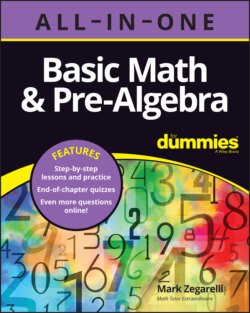Читать книгу Basic Math & Pre-Algebra All-in-One For Dummies (+ Chapter Quizzes Online) - Mark Zegarelli - Страница 56
Sign-Switching: Understanding Negation and Absolute Value
ОглавлениеWhen you attach a negative sign to any number, you negate that number. Negating a number means changing its sign to the opposite sign, so
Attaching a negative sign to a positive number makes it negative.
Attaching a negative sign to a negative number makes it positive. The two adjacent (side-by-side) negative signs cancel each other out.
Attaching a negative sign to 0 doesn’t change its value, so .
In contrast to negation, placing two bars around a number gives you the absolute value of that number. Absolute value is the number’s distance from 0 on the number line — that is, it’s the positive value of a number, regardless of whether you started out with a negative or positive number:
The absolute value of a positive number is the same number.
The absolute value of a negative number makes it a positive number.
Placing absolute value bars around 0 doesn’t change its value, so .
Placing a negative sign outside absolute value bars gives you a negative result — for example, .
Q. Negate the number 7.
A. −7. Negate 7 by attaching a negative sign to it: −7.
Q. Find the negation of −3.
A. 3. The negation of . The two adjacent negative signs cancel out, which gives you 3.
Q. What’s the negation of ?
A. 5. First, do the subtraction, which tells you . To find the negation of −5, attach a negative sign to the answer: . The two adjacent negative signs cancel out, which gives you 5.
Q. What number does equal?
A. 9. The number 9 is already positive, so the absolute value of 9 is also 9.
Q. What number does equal?
A. 17. Because −17 is negative, the absolute value of .
Q. Solve this absolute value problem:
A. −4. Do the subtraction first: , which is negative, so the absolute value of . But the negative sign on the left (outside the absolute value bars in the original expression) negates this result, so the answer is −4.
3 Negate each of the following numbers and expressions by attaching a negative sign and then canceling out negative signs when possible:
(a)
(b)
(c)
(d)
(e)
(f)
4 Solve the following absolute value problems:
(a)
(b)
(c)
(d)
(e)
(f)
